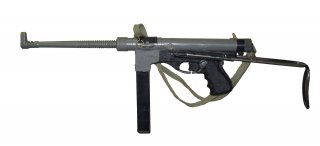Belgium’s Vigneron Submachine Gun—A Gun That Took The Best of Other Guns
It was great for “street fighting.”
While the submachine gun was first employed at the end of the World War I, with Germany’s MP18 being the first successful compact automatic weapon, the development continued in the interwar era with countries such as the United States developing the Thompson and Germany's military refining the concept with the MP40.
However, submachine gun development reached its apex after World War II when new designs were heavily influenced by the weapons used by the various combatant nations.
Among the lesser-known weapons to come out of the post-World War II era was the Belgian Vigneron—a selective-fire submachine gun that proved perfect for bush fighting but also for close combat street fighting.
It was used in both!
While Belgium was one of the nations occupied by the Germans during World War II, its arms industry, which was centered on Fabrique Nationale (FN/Browning) in Herstal, was pressed into service to produce weapons for the Nazis. After the war, the Belgian Army relied heavily on foreign equipment—most coming from the United States and the United Kingdom—but the Belgian arms industry was ready to begin producing new weapons. It soon developed notable weapons including the FN FAL, which was also adopted by the British as the L1A1 Self-Loading Rifle, the first widely adopted semi-automatic rifle of the British Army.
Belgian Colonel Georges Vigneron took the lead on a new domestically-produced machine pistol or submachine gun in the early 1950s. Vigneron borrowed elements from other weapons including a compensator from the American Thompson, the wire stock and hinged dust cover from the M3 “Grease Gun,” the bolt design from the British Sten and the stick magazine from the German MP40.
It had an appearance that seemed similar to the MP40 and M3, and relied on a simple blowback operation that provided a rate of fire of up to 620 minutes. The weapon was chambered in 9x19-millimeter Parabellum due to the fact that there were then untold stocks of surplus ammunition from the war.
It was heavy for a submachine gun, weighting 8.1 pounds with a full 32-round magazine, but it was also compact and with a collapsed stock it had an overall length of just 24 inches—while when the stock was fully deployed it was still just 28 inches, and still shorter than the length of the M1 Carbine.
The weapon's operation was unique to say the least. It had a grip safety that needed to be depressed and locked the bolt to the rear when not depressed, while the selector switch featured the semi-automatic, full-automatic and safe. However, when set on automatic a light trigger pull could still get off single shots while a harder pull would jump to the full automatic.
The magazine was a near-direct copy of one employed with the MP40, and most sources suggest that it was fully compatible—a move based on the sheer number of surplus magazines in the 1950s when the gun was developed.
The Vigneron M1 was adopted by the Belgian Army in 1953, and some twenty-one thousand were produced; while another sixty thousand some M2 versions were subsequently produced beginning later that same year. The improvements were minor and included a front sight protector, a rear sight notch replaced a peep sight and the dust cover was improved.
The weapon was simple to operate but was more importantly quite easy to maintain. It was primarily made of stamped steel metal with a plastic grip. It still proved rugged enough when used by the Belgian Army and mercenary forces during the Congo Crisis. It was also by the Portuguese military as the Pistola Metralhadora M/961 in its colonial wars and later by post-Belgian and post-Portuguese government and insurgent forces in the Congo, and Rwanda—a lasting remnant of the bloody wars of the 1950s to 1970s.
The Irish Republican Army also reportedly acquired small quantities of the Vigneron and it proved as reliable in the concrete jungles during the Troubles as it had in the actual jungles of Africa.
Peter Suciu is a Michigan-based writer who has contributed to more than four dozen magazines, newspapers and websites. He is the author of several books on military headgear including A Gallery of Military Headdress, which is available on Amazon.com.

